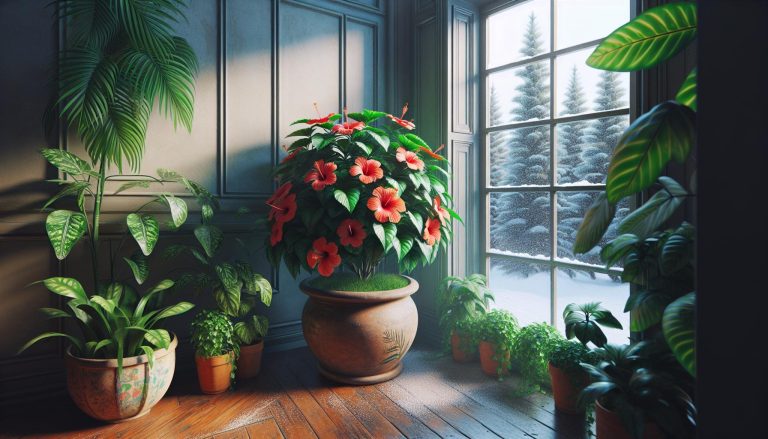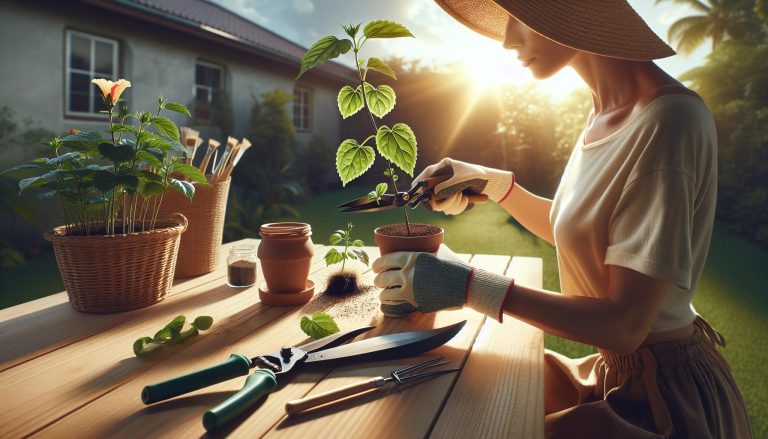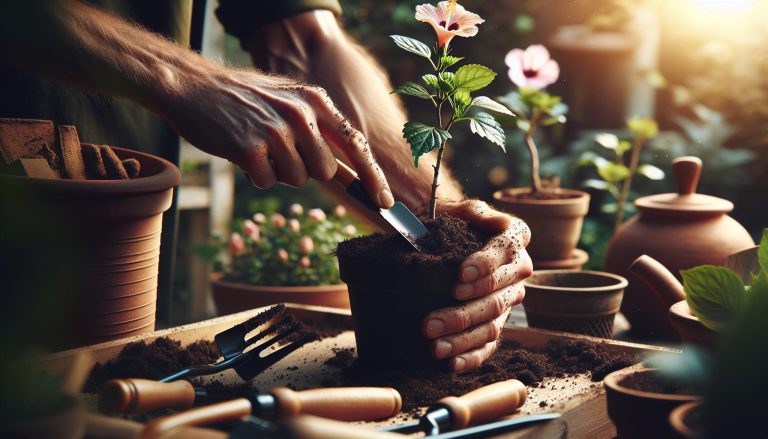Painted Lady Hibiscus Care & Growing Tips
As a child, I spent countless hours in my grandmother’s garden, marveling at the vibrant blooms and lush greenery. One plant, in particular, always stood out to me – the Painted Lady Hibiscus. Its stunning tropical flowers, with their intricate patterns and vibrant colors, captured my imagination and ignited a passion for gardening that has stayed with me to this day.
The Painted Lady Hibiscus is not just a plant; it’s a work of art. With its ornamental beauty and graceful presence, it has the power to transform any flower garden or landscape into a breathtaking oasis. This tropical wonder demands attention and admiration with every blossom it produces. From its deep green foliage to its show-stopping flowers, the Painted Lady Hibiscus is a true gardening beauty.
Key Takeaways:
- The Painted Lady Hibiscus is a tropical evergreen shrub with dark green foliage.
- It blooms from spring through fall, adding vibrant colors to flower gardens and landscaping projects.
- Full sunlight and regular watering are essential for the continued success of this beautiful plant.
- The Painted Lady Hibiscus is a gorgeous addition to any home or garden, prized for its lush tropical flowers.
- By following the care and growing tips outlined in this article, you can ensure the thriving of your Painted Lady Hibiscus plants and enjoy their stunning blooms.
Description of Painted Lady Hibiscus
The Painted Lady Hibiscus, also known as Hibiscus Rosa-Sinensis, is a popular indoor flowering plant native to Asia. This tropical plant can be found in tropical and subtropical regions. It produces beautiful trumpet-shaped blossoms in vibrant colors, making it a stunning addition to any home or garden.
The Painted Lady Hibiscus is prized for its lush tropical flowers, which are known for their vibrancy and beauty. The blooms come in a variety of colors, including shades of red, pink, orange, and yellow. The large flowers are sure to catch the eye and add a burst of color to any space.
One of the remarkable features of the Painted Lady Hibiscus is the longevity of its blooms. The flowers can last for several days, providing a lasting display of vibrant color and beauty. This makes the plant a favorite choice for those looking to add a touch of tropical elegance to their indoor spaces.
Whether placed in a sunny window or used as a centerpiece on a dining table, the Painted Lady Hibiscus is sure to brighten up any room. Its striking blooms and glossy green foliage create a stunning visual contrast that adds warmth and vibrancy to indoor environments.
This tropical plant can also be incorporated into outdoor landscapes, especially in regions with mild climates. Its vibrant blooms can be used as a focal point in flower beds or as a colorful border along walkways and garden paths. The Painted Lady Hibiscus adds a touch of tropical paradise to any garden or landscape.
For those looking to attract pollinators, the Painted Lady Hibiscus is a fantastic choice. Bees, butterflies, and hummingbirds are attracted to the vibrant blooms, making it a source of nectar and beauty for these beneficial creatures. By incorporating this plant into your outdoor space, you can create a haven for pollinators and contribute to the overall health of your garden ecosystem.
Overall, the Painted Lady Hibiscus is a stunning plant that adds a tropical touch to any environment. Its vibrant blooms, coupled with its easy care requirements, make it a favorite choice among gardeners. Whether grown indoors or outdoors, this plant is sure to bring joy and beauty wherever it is planted.
Light Requirements for Painted Lady Hibiscus
The Painted Lady Hibiscus, also known as Hibiscus Rosa-Sinensis, is a stunning tropical plant that thrives in abundant sunlight. It prefers full sunlight to encourage optimal growth and vibrant blooms, especially in northern climates. Placing the plant in a location that receives direct sunlight for at least 6 to 8 hours a day will help it thrive.
However, in hot and arid regions, providing partial shade during the hottest parts of the day can prevent the leaves from scorching and keep the plant healthier. This is especially important during intense summer months when the sun’s rays are particularly intense.
If you’re growing the Painted Lady Hibiscus indoors, make sure to place it near a window that receives ample sunlight throughout the day. This will provide the ideal light conditions for the plant’s growth and ensure it receives sufficient energy for photosynthesis.
Signs of Inadequate Light
It’s important to monitor your Painted Lady Hibiscus for any signs of inadequate light. If the plant isn’t receiving enough sunlight, it may exhibit the following symptoms:
- Stunted growth
- Pale or yellowing leaves
- Poor blooming or no blooms
These signs indicate that the plant needs more sunlight to thrive. If you notice any of these symptoms, consider moving your hibiscus to a brighter location with full sunlight exposure.
Adjusting Light Conditions
While Painted Lady Hibiscus thrives in full sunlight, it’s important to consider the specific climate conditions in your area. In extremely hot and arid regions, the plant may require some shade during the hottest part of the day to avoid stress and leaf scorching.
For outdoor hibiscus plants, you can provide shade by placing them near taller plants or utilizing shading devices such as umbrellas or shade cloths. This will help create a microclimate that offers partial shade during the peak sun hours.
Remember, finding the right balance between full sunlight and partial shade is essential to ensure the optimal growth and health of your Painted Lady Hibiscus.

| Light Requirements | Conditions |
|---|---|
| Full Sunlight | 6 to 8 hours of direct sunlight daily |
| Partial Shade | Protection from intense midday sunlight |
Soil Requirements for Painted Lady Hibiscus
Proper soil is essential for the health and growth of Painted Lady Hibiscus plants. Whether you are growing them in containers or in your garden, it’s important to provide well-drained soil that promotes healthy roots and prevents waterlogging and diseases.
When cultivating Painted Lady Hibiscus in containers, it is best to use a well-drained potting mix. This ensures that the excess water can drain out easily, preventing the roots from sitting in water for too long. Well-drained soil allows the roots to access oxygen and prevents the risk of root rot.
For outdoor cultivation, you can improve the quality of the soil by adding organic ingredients such as compost or well-rotted manure. These organic materials enrich the soil and provide essential nutrients to the plants. However, it is crucial to ensure that the soil remains well-draining even after the addition of organic matter.
Before planting your Painted Lady Hibiscus, it’s a good idea to prepare the soil by loosening it and removing any weeds or debris. This allows the roots to establish themselves easily and promotes better nutrient absorption.
Incorporating well-drained soil into your gardening routine will ensure that your Painted Lady Hibiscus thrives and produces vibrant, beautiful blooms.
Watering Needs for Painted Lady Hibiscus
The Painted Lady Hibiscus, like many tropical flowers, relies on regular watering to thrive. Proper watering is essential for maintaining the health and vibrancy of these beautiful plants. The amount and frequency of watering depend on the humidity levels in your area, as well as other factors such as the size of the plant and the type of soil it is planted in.
For the best results, it is recommended to provide 1 to 2 inches of water per week for your Painted Lady Hibiscus. This amount can be adjusted based on the specific needs of your plant and the current weather conditions. In high humidity areas, additional watering may be necessary to match the moisture levels and prevent the soil from drying out.
To determine when your hibiscus plant needs watering, there are a few signs to look out for. Check the moisture level of the soil by inserting your finger about an inch deep. If it feels dry, it’s time to water your plant. Additionally, wilting leaves and a dull appearance can indicate that your hibiscus is thirsty and in need of hydration.
When watering your Painted Lady Hibiscus, it’s important to do so gently and evenly. Avoid overwatering, as this can lead to root rot and other issues. Ensure that the water reaches the root zone of the plant and penetrates the soil deeply. Mulching the soil around the base of the plant can help retain moisture and reduce water evaporation.
Remember that the specific watering needs of your Painted Lady Hibiscus may vary depending on the growing conditions and environmental factors in your location. Pay attention to the moisture content of the soil, the appearance of the leaves, and the overall health of the plant to determine the optimal watering schedule for your hibiscus.
Proper Humidity Levels
In addition to regular watering, the humidity levels in your environment can also affect the health and growth of your Painted Lady Hibiscus. These tropical flowers thrive in humid conditions, and maintaining an appropriate level of humidity can promote lush foliage and vibrant blooms.
If you live in a dry or arid climate, you may need to provide extra humidity for your hibiscus plant. There are several ways to increase humidity around your plants. One method is to place your hibiscus on a tray filled with pebbles and water. As the water evaporates, it creates a humid microclimate around the plant. Alternatively, you can use a humidifier or mist the leaves of your hibiscus regularly with water.
Monitoring the humidity levels in your home or garden can help you assess whether additional measures are necessary to create the ideal growing environment for your Painted Lady Hibiscus. By maintaining adequate watering and humidity levels, you can ensure that your hibiscus plant thrives and rewards you with its stunning tropical beauty.

Fertilizing Painted Lady Hibiscus
To ensure the healthy growth of your Painted Lady Hibiscus plant and promote vibrant blooms, proper fertilization is essential. A slow-release fertilizer is recommended to provide a steady supply of nutrients without the need for frequent additional feeding. This allows the hibiscus plant to absorb the necessary nutrients at a consistent pace, resulting in optimum growth and flowering.
When fertilizing your Painted Lady Hibiscus, it is recommended to mix the slow-release fertilizer into the soil. This ensures that the nutrients are evenly distributed, benefiting the entire root system. Use a garden fork or a small trowel to gently work the fertilizer into the soil around the base of the plant.
After a few months of the initial fertilization, you can supplement the slow-release fertilizer with diluted fish emulsion for extra nutrition. Fish emulsion is a natural fertilizer that provides essential macronutrients and micronutrients, promoting healthy foliage and robust blooms.
Remember to follow the instructions provided by the manufacturer for both the slow-release fertilizer and the fish emulsion to ensure proper usage and avoid over-fertilization. It’s important to fertilize your Painted Lady Hibiscus regularly, especially during the growing season, to support its nutrient needs and encourage continuous blooming.
By fertilizing your Painted Lady Hibiscus with a slow-release fertilizer and supplementing with diluted fish emulsion, you can provide the necessary nutrients for healthy growth and vibrant tropical flowers. Remember to always monitor your plant’s response to fertilization and adjust the feeding schedule as needed.
Common Issues with Painted Lady Hibiscus
While the Painted Lady Hibiscus is generally resistant to pests and diseases, it’s important to be aware of a few common issues that can arise. Being proactive in addressing these problems will help ensure the health and vitality of your hibiscus plants.
Pests
Two common pests that can affect indoor hibiscus plants are spider mites and aphids. Spider mites are tiny arachnids that feed on the plant’s sap, leaving behind webbing and causing yellowed leaves. Aphids are small insects that also feed on plant sap, resulting in distorted growth and a sticky residue known as honeydew.
To get rid of these pests, you can use a mixture of liquid detergent and water to wash away spider mites. For aphids, applying neem oil or insecticidal soap can be effective in eliminating the infestation. Regularly inspecting your hibiscus plants and taking immediate action at the first sign of pests will help prevent them from becoming a more significant problem.
Diseases
Bacterial diseases can sometimes occur in hibiscus plants, especially if there has been an infestation of pests or prolonged periods of excessive rain. These diseases can manifest as leaf wilting, yellowing, or dark spots on the foliage. To prevent the occurrence of bacterial diseases, it’s crucial to maintain good plant health and minimize conditions that promote bacterial growth.
Monitoring and Prevention
Regularly monitoring the health of your Painted Lady Hibiscus plants is essential for identifying and addressing any issues promptly. Keep an eye out for changes in foliage color, texture, or overall plant vigor. If you notice any signs of pest infestation or disease, take immediate action to prevent further damage.
Proper cultural practices, such as providing adequate sunlight, watering appropriately, and ensuring good airflow around the plants, can contribute to the overall health and resilience of your hibiscus plants. Additionally, maintaining cleanliness in the growing area and promptly removing any fallen leaves or debris can help prevent the buildup of pests or diseases.
By being vigilant and proactive in addressing common issues, you can enjoy healthy and beautiful Painted Lady Hibiscus plants in your garden or indoor space.
| Common Issues | Pests and Diseases |
|---|---|
| Spider Mites | Feed on plant sap, leaving behind webbing and causing yellowed leaves. |
| Aphids | Feed on plant sap, resulting in distorted growth and a sticky residue known as honeydew. |
| Bacterial Diseases | Can occur due to pest infestations or excessive rain, causing leaf wilting, yellowing, or dark spots on foliage. |
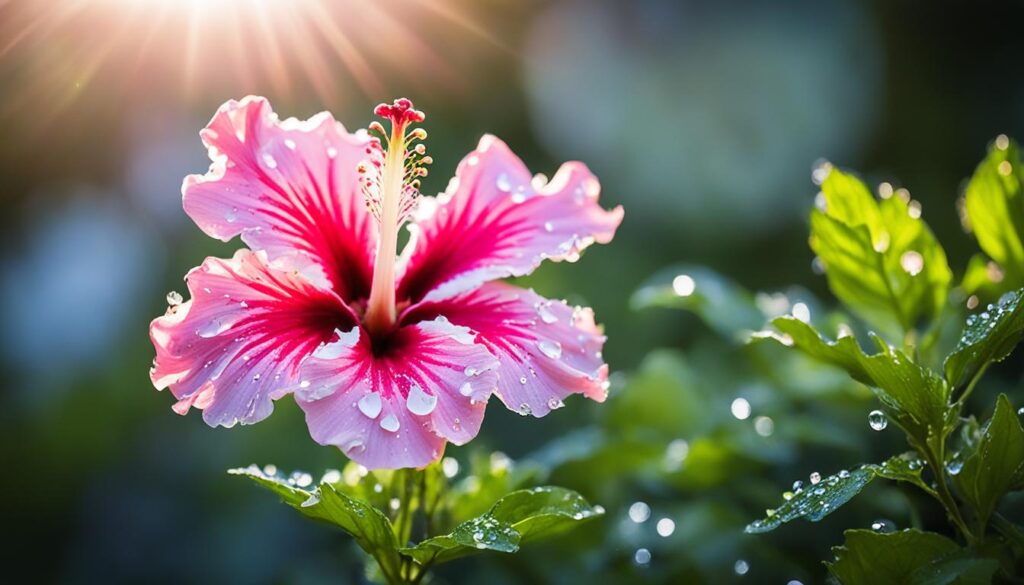
Pruning and Propagation of Painted Lady Hibiscus
Pruning is a crucial aspect of maintaining the health and vitality of your Painted Lady Hibiscus. By pruning in the fall, you can stimulate new growth and encourage the plant to maintain its desired shape. Additionally, pruning helps to ensure abundant flowering, allowing your hibiscus plant to showcase its vibrant blooms.
When pruning the Painted Lady Hibiscus, start by removing any dead, damaged, or diseased branches. This will not only improve the overall appearance of the plant but also prevent the spread of pests or diseases. Next, you can selectively trim back any overgrown or unruly branches to maintain a compact and well-shaped plant.
To propagate new Painted Lady Hibiscus plants, you can use cuttings taken during the active growth period in spring or early summer. Start by selecting a healthy stem and cutting it just below a leaf node using a clean, sharp pair of pruning shears. Remove any lower leaves, leaving only a few at the top of the cutting.
Once you’ve prepared the cutting, you can dip the cut end into rooting hormone to promote root development. Next, plant the cutting in a well-draining potting mix and place it in a warm and humid environment. Mist the cutting regularly to maintain moisture levels and encourage root growth.
With proper care and attention, the cutting will develop roots and eventually grow into a new Painted Lady Hibiscus plant that is genetically identical to the parent plant.
Pruning and propagation are essential practices for maintaining the health and growth of your Painted Lady Hibiscus. By pruning in the fall and propagating through cuttings, you can ensure that your hibiscus plants continue to thrive and bring beauty to your garden or landscape.
Tips for Pruning and Propagation
- Prune the Painted Lady Hibiscus in the fall to stimulate new growth and maintain shape
- Remove dead, damaged, or diseased branches during pruning
- Trim back overgrown branches to maintain a compact plant
- Use clean, sharp pruning shears to prevent the spread of diseases
- Take cuttings during the active growth period in spring or early summer for propagation
- Apply rooting hormone to the cut end of the cutting to promote root development
- Plant the cutting in a well-draining potting mix and keep it in a warm, humid environment
- Mist the cutting regularly to maintain moisture and encourage root growth
Potting and Repotting Painted Lady Hibiscus
Proper potting and repotting are essential for the healthy growth of your Painted Lady Hibiscus. Repotting should be done every two years to ensure that the soil provides adequate nutrients for the plant’s development. Additionally, using deep containers can promote continuous flowering, allowing the tropical beauty of the hibiscus blooms to shine.
When repotting your Painted Lady Hibiscus, it’s important to handle the plant with care. Gently remove the plant from its current pot, taking care not to damage the roots. Inspect the roots for any signs of damage or disease and trim them if necessary.
Before placing the plant in its new pot, provide proper soil support to avoid any damage during transportation. Fill the new pot with well-drained potting mix, ensuring it is suitable for tropical flowers like the Painted Lady Hibiscus. Place the plant in the center of the pot, adding more soil around it, and gently pressing it down to eliminate any air pockets.
After repotting, water the plant thoroughly to help settle the soil. Avoid overwatering, as this can lead to root rot. Ensure that excess water drains out of the pot to prevent waterlogged roots.
Remember to regularly monitor the condition of the potting mix and consider repotting if it becomes compacted or nutrient-deficient. By providing proper potting care and repotting as needed, you can help your Painted Lady Hibiscus thrive and continue to grace your garden with its vibrant and tropical blooms.
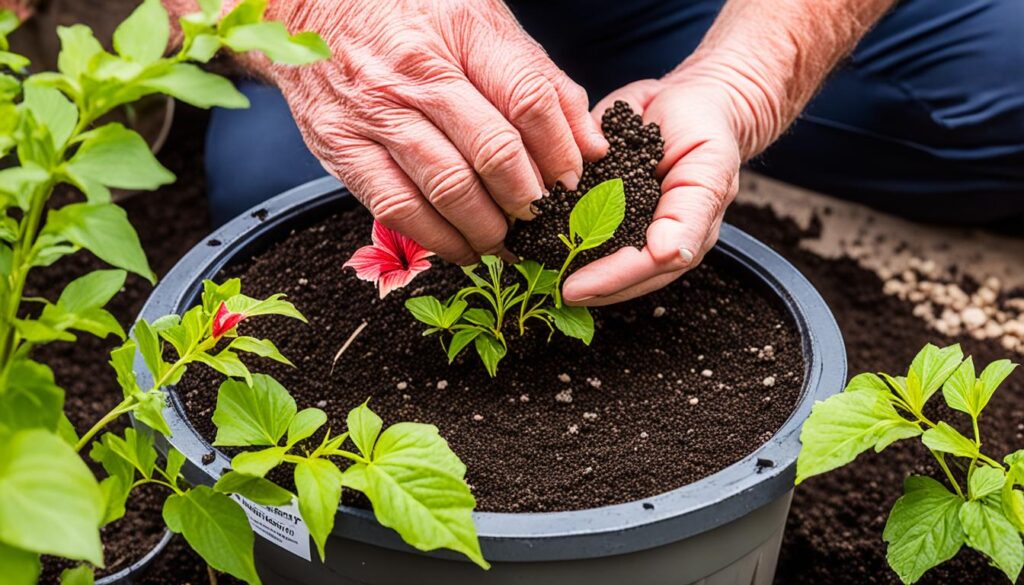
Benefits of Repotting Painted Lady Hibiscus
Repotting your Painted Lady Hibiscus on a regular basis offers numerous benefits for the plant’s health and growth. Some of these benefits include:
- Renewed Nutrients: Repotting provides fresh and nutrient-rich soil, ensuring that your hibiscus has access to the necessary minerals and nutrients for its growth.
- Improved Drainage: As the potting mix in the current pot may become compacted over time, repotting allows for the use of well-draining soil, preventing waterlogging and root rot.
- Root Health: Repotting allows you to inspect the roots and trim any damaged or diseased portions, promoting the overall health of the plant.
- Continued Flowering: The use of deep containers during the repotting process promotes continuous flowering, allowing you to enjoy the colorful blooms of your Painted Lady Hibiscus.
By incorporating regular repotting into your hibiscus care routine, you can ensure that your Painted Lady Hibiscus remains vibrant, healthy, and a focal point of your garden.
Ideal Growing Zones for Painted Lady Hibiscus
The Painted Lady Hibiscus is a tropical plant that thrives in specific hardiness zones. Understanding the ideal growing zones for this beautiful hibiscus plant is crucial for its successful cultivation. Knowing your region’s hardiness zone can help determine whether the Painted Lady Hibiscus will flourish in your area.
Hardiness Zones and Climate
Hardiness zones categorize geographical areas based on their average annual minimum temperatures. They serve as a guide to determine which plants can withstand the climatic conditions in a particular region. The Painted Lady Hibiscus is best suited for growing in Zones 9 to 11, where the temperatures range from approximately 20°F (-6°C) to 40°F (4°C).
In Zone 9, the winters are mild, and frost is rare. This zone includes regions like southern Florida, parts of Texas, and coastal California. Zone 10 encompasses areas with even milder winters, such as southern Florida, southern Texas, and the southernmost parts of Arizona and California. Zone 11 is characterized by year-round warmth and includes regions like southern Florida, Hawaii, and Puerto Rico.
Determining Your Hardiness Zone
If you are unsure which hardiness zone you reside in, several resources are available to help you determine the suitability of growing the Painted Lady Hibiscus in your area. The United States Department of Agriculture (USDA) provides an interactive hardiness zone map that allows you to search for your zone based on your zip code. Many gardening websites also offer zone finders that provide the necessary information based on your location.
Considerations for Zones outside 9-11
If you live outside of Zones 9 to 11, it may still be possible to grow the Painted Lady Hibiscus. However, it will require special attention and care to provide the necessary growing conditions. In colder regions, growing the hibiscus plant in containers that can be brought indoors during winter is a popular option. This allows for better control over temperature and protects the plant from frost.
It’s important to note that although the Painted Lady Hibiscus may survive in zones outside 9-11, it may not thrive or produce as many vibrant blooms as it would in its ideal growing zones. Therefore, it’s recommended to research and understand the specific needs and challenges associated with growing this tropical beauty in your region.
To determine your hardiness zone and ensure the optimal growing conditions for the Painted Lady Hibiscus, use online resources or consult local gardening experts who can provide tailored advice based on your specific location.
| Hardiness Zone | Temperature Range (°F) | Representative Regions |
|---|---|---|
| 9 | 20°F to 30°F | Southern Florida, parts of Texas, coastal California |
| 10 | 30°F to 40°F | Southern Florida, southern Texas, southern Arizona, southern California |
| 11 | 40°F and above | Southern Florida, Hawaii, Puerto Rico |
Pet-Friendly Nature of Painted Lady Hibiscus
The Painted Lady Hibiscus is a perfect choice for pet owners who want to add a touch of tropical beauty to their homes. This stunning hibiscus plant is considered pet-friendly, as it does not pose any known toxicity risks to animals.
When it comes to ensuring the safety of your furry friends, it’s always best to monitor their behavior around new plants, including the Painted Lady Hibiscus. While this plant is unlikely to cause harm if ingested, it’s still important to prevent pets from chewing on it.
To create a harmonious environment for both your pet and the Painted Lady Hibiscus, consider these simple tips:
- Keep the plant out of reach of curious pets, especially puppies and kittens who may be more prone to exploring and chewing on plants.
- Consider using a plant stand or hanging basket to elevate the hibiscus plant, making it less accessible to pets.
- Train your pets to avoid chewing on plants by offering them suitable alternatives, such as chew toys or bones.
- Supervise your pets when introducing them to new areas where the hibiscus is planted, reinforcing boundaries through positive reinforcement.
- Incorporate other pet-friendly plants into your indoor or outdoor space to provide additional plant options for your pet’s curiosity.
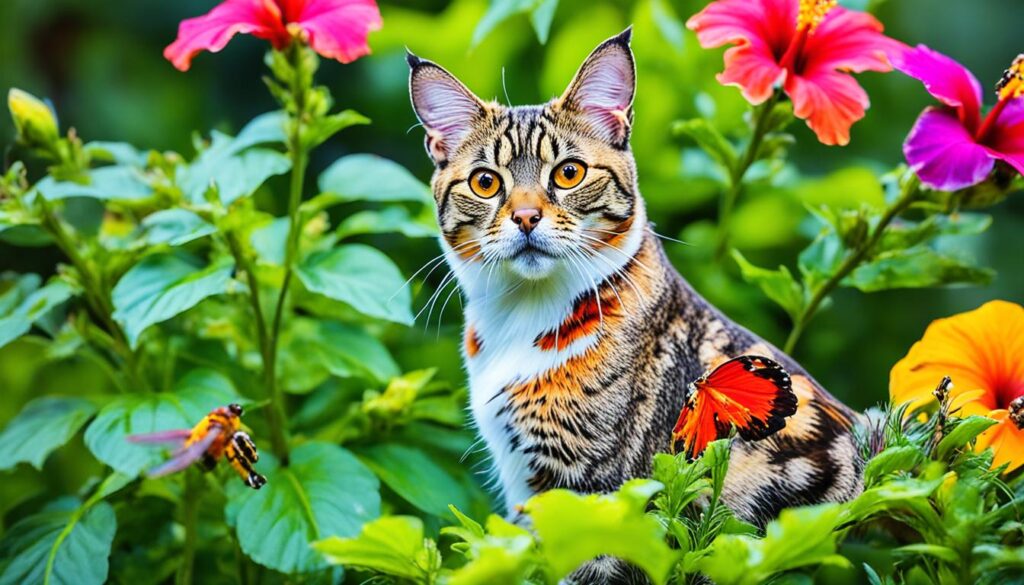
A beautiful and non-toxic addition to any pet-friendly home, the Painted Lady Hibiscus brings the beauty of tropical flowers without compromising the safety of your furry companions.
Benefits of Painted Lady Hibiscus in Gardens and Landscapes
The vibrant blooms of the Painted Lady Hibiscus make it an attractive addition to flower gardens and landscape designs. Its tropical beauty adds a touch of elegance and grace to any outdoor space. Whether used as a focal point or mixed with other plants, this ornamental shrub brings beauty and color to gardens and landscapes.
If you’re looking to create a stunning flower garden, the Painted Lady Hibiscus is an excellent choice. Its vibrant blooms, available in a variety of colors, will add a burst of color and life to your garden. These tropical flowers are sure to catch the eye and create a vibrant focal point in any garden.
Enhancing Landscape Designs
The Painted Lady Hibiscus is not only perfect for flower gardens but also for enhancing landscape designs. Its lush foliage and vibrant blossoms can be incorporated into various landscaping themes to create stunning visual displays. Whether used as a border plant, planted in groups for a mass effect, or strategically placed as a standalone specimen, the Painted Lady Hibiscus adds a touch of exotic beauty to outdoor spaces.
Consider planting the Painted Lady Hibiscus around your patio or deck area to create a tropical oasis right in your backyard. Its vibrant blooms and lush green foliage will transport you to a tropical paradise, making every day feel like a vacation.
Low-Maintenance and Durable
Aside from its stunning beauty, the Painted Lady Hibiscus is a low-maintenance plant that can withstand various weather conditions. It is known for its durability and ability to thrive in both hot and humid climates. This makes it an ideal choice for landscaping in tropical and subtropical regions.
Whether you’re an experienced gardener or a beginner, the Painted Lady Hibiscus is a forgiving plant that requires minimal care. With proper watering, sunlight, and occasional pruning, it will reward you with vibrant blooms throughout the year. Its ability to adapt to different soil types and withstand mild drought makes it a resilient addition to any landscape.
Attracting Wildlife
The nectar-rich flowers of the Painted Lady Hibiscus attract various pollinators such as bees, butterflies, and hummingbirds. By planting this ornamental shrub in your garden or landscape, you can create a haven for these beneficial creatures. Not only will you enjoy the vibrant blooms, but you’ll also contribute to the ecosystem by supporting pollinators and other wildlife.
Versatile Design Options
One of the greatest advantages of the Painted Lady Hibiscus is its versatility in design options. You can incorporate it into various garden styles, including tropical, Mediterranean, or formal gardens. Its vibrant colors and stunning blooms can complement other plants and flowers, creating a harmonious and visually appealing landscape.
Consider planting the Painted Lady Hibiscus as a hedge or border to create a natural and colorful barrier in your garden. The pops of vibrant colors will not only provide privacy but also enhance the overall aesthetic of your outdoor space.
Adding Year-Round Beauty
The Painted Lady Hibiscus is an evergreen shrub that blooms from spring through fall, providing year-round beauty to your garden or landscape. Its vibrant blooms will brighten up your outdoor space and create a cheerful atmosphere, even during the colder months. This longevity of blooming makes it a valuable addition to any garden or landscape design.
Whether you’re looking to create a vibrant flower garden or enhance your landscape design, the Painted Lady Hibiscus is a versatile and stunning choice. Its vibrant blooms, low-maintenance nature, and ability to attract wildlife make it a prized ornamental plant. Incorporating the Painted Lady Hibiscus into your outdoor space will add a touch of elegance, color, and tropical beauty that will be admired by all.
Conclusion
The Painted Lady Hibiscus is a stunning and versatile plant that adds tropical beauty to gardens and landscapes. With its vibrant blooms and lush foliage, this hibiscus plant is sure to capture attention and bring a touch of gardening beauty to any outdoor space.
By following the care and growing tips outlined in this article, you can ensure that your Painted Lady Hibiscus thrives and produces an abundance of colorful blossoms. From providing the right amount of sunlight to maintaining well-drained soil, these simple steps will help your hibiscus plant flourish.
Whether you choose to grow the Painted Lady Hibiscus as a single specimen or in mass plantings, its ornamental beauty will enhance any landscape or flower garden. Its vibrant colors and tropical allure make it a popular choice among gardening enthusiasts, adding a touch of elegance and grace to outdoor spaces.
So go ahead, incorporate the Painted Lady Hibiscus into your garden or landscape design and enjoy the gardening beauty it brings. With its stunning blooms and easy care requirements, this tropical flower is sure to be a delightful addition to your gardening repertoire.



